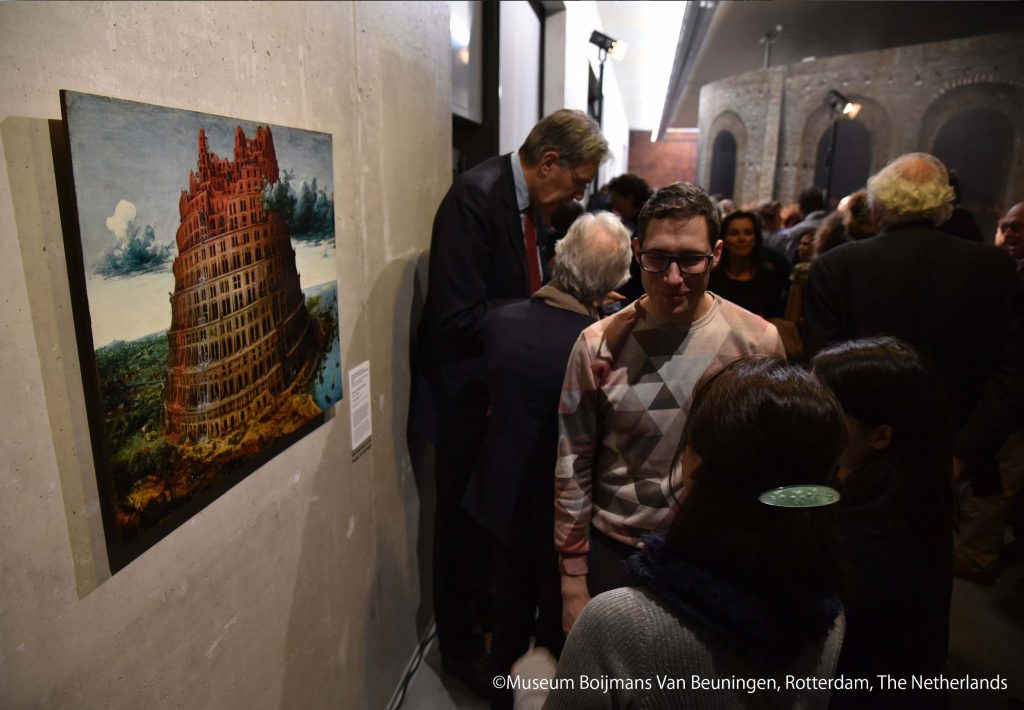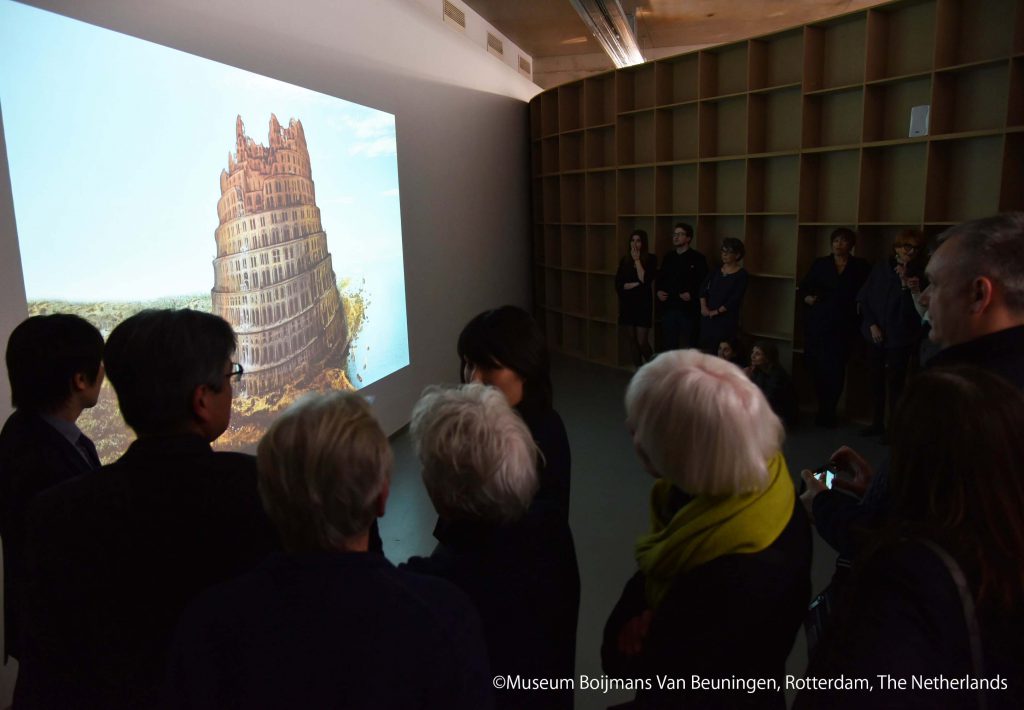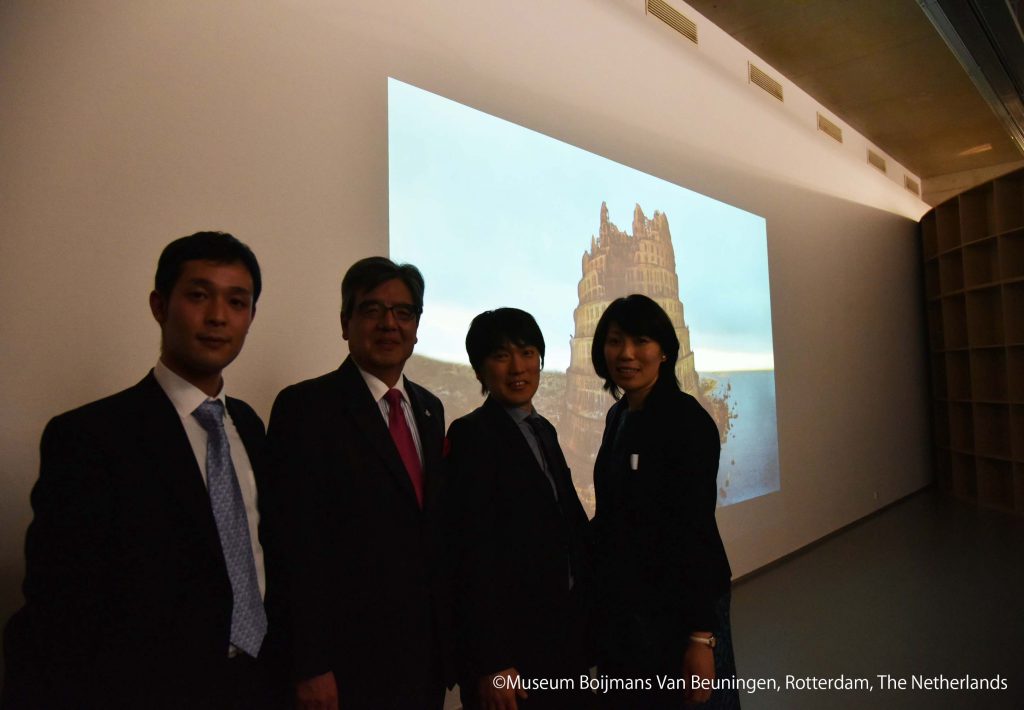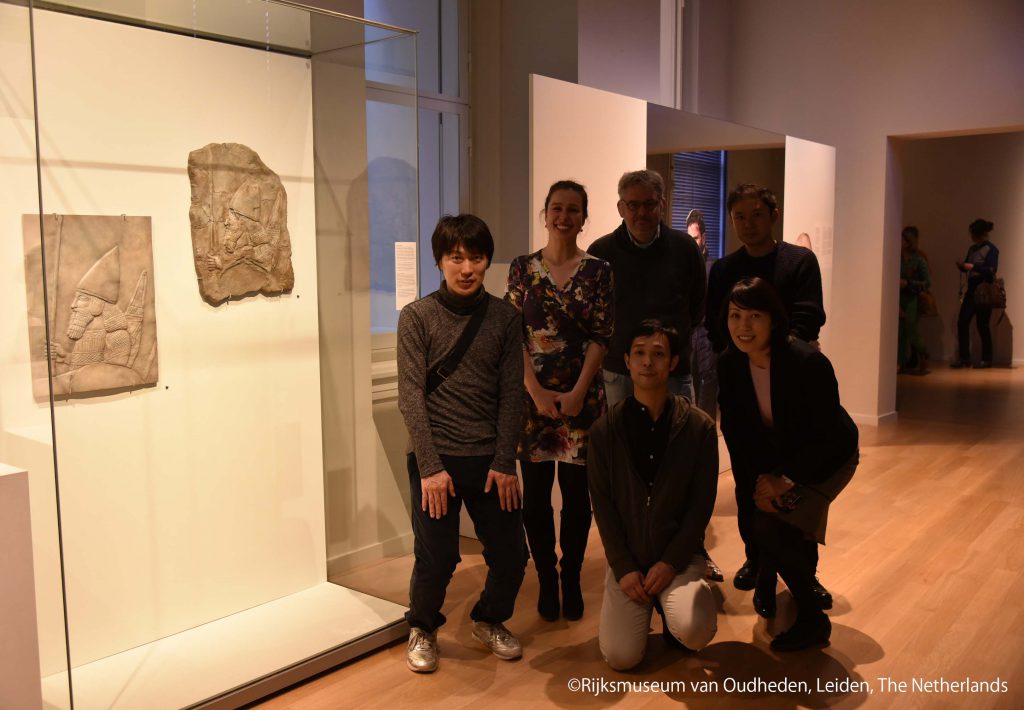ボイマンス美術館「BABEL: Old Masters Back from Japan」展への参加Participation in the exhibition “BABEL: Old Masters Back from Japan”
May 21, 2018
2月9日、オランダのボイマンス美術館で「BABEL: Old Masters Back from Japan」展の国際記者発表ならびにオープニングレセプションと内覧会が開催され、本学から5名がオープニングレセプションに招待されて出席しました。
9日昼の欧米主要プレス関係者に向けた記者発表会の冒頭で、Sjarel Exボイマンス美術館館長から、本展覧会は昨年東京と大阪で開催されたボイマンス美術館所蔵ブリューゲル「バベルの塔」展(朝日新聞社等主催)ならびに東京で開催された「Study of BABEL」展(東京藝術大学・東京藝術大学COI拠点主催)での成功を受けて日本とのコラボレーションにより開催するものであり、日本での展覧会から多くのインスピレーションを得て様々な展示を試みたと説明がありました。

国際記者発表会の模様
その後、今回の展示ルートの最初を飾る「バベルの塔」の高精細複製画(クローン文化財)について本学COI拠点の田中眞奈子講師が紹介すると、欧州から集まった約20人のプレス関係者らはメモをとりつつ熱心に聞き入っていました。
この作品は本学COI拠点とNICAS(オランダ芸術科学保存協会)とが連携し、芸術と科学との融合により制作されたものです。具体的にはデルフト工科大学の.Joris Dik教授が高分解能の蛍光X線装置を用いて行った「バベルの塔」の組成のマッピング(分布)分析によりこの絵に用いられている絵の具を調査し、科学分析によって得られた情報をもとに本学COI拠点が一部の組成までもオリジナルと一致させたクローン文化財を制作しました。複製の板材にはオリジナルと同じオークを用い、絵具もブリューゲルが使用していたスマルトとバーミリオンの2つの油絵の具をオリジナルと全く同じ部分に用いています。
また、展覧会場の特設映写室では、「BABEL: Old Masters Back from Japan」展のために本学COI拠点が新たに編集・制作したバベルの塔の3D映像をはじめとする映像作品2点が上映され、真に迫るバベルの塔の描写がプレスの注目を集めました。
同日夜に開催された展覧会のオープニングレセプションと内覧会はEx館長を中心とする関係者によるテープカットで華やかに幕を開け、猪俣弘司駐オランダ日本国大使をはじめとする約1500名のVIPが、「BABEL: Old Masters Back from Japan」展を鑑賞しました。デジタル技術とアナログ技術を融合させた本学COI拠点の展示物には参加者から感嘆の声あがり、多くの反響がありました。
 「BABEL: Old Masters Back from Japan」展の開幕を祝ったテープカット
「BABEL: Old Masters Back from Japan」展の開幕を祝ったテープカット

内覧会風景(藝大COI拠点とデルフト工科大学の連携による「バベルの塔」の高精細複製画)

内覧会風景(藝大COI拠点によるバベルの塔の3D映像)
翌2月10日、訪蘭の機会を利用して、本学COI拠点メンバーは共同研究のパートナーであるDik教授とともにオランダ国立古代博物館『ニネヴェ展』を訪れ、同展で展示されている本学COI拠点作成のレリーフのクローン文化財についての反響のヒアリングや今後の共同研究の打ち合わせを行ないました。ニネヴェ展では、2次元の写真データを基に、ISによって壊された中東地域にある古代ニネヴェ遺跡のレリーフを3次元化し高精細複製を制作するという新しい試みに取り組みました。
科学と芸術の融合により、貴重な文化財の「保存」と「公開」という相反する責務を果たすことが出来るだけでなく、オリジナルを超えるような新しい価値の創造や感動の創出が可能となります。藝大COI拠点では、引き続き国際的な視点で新たな挑戦を続けてまいります。

猪俣駐オランダ日本国大使と本学の3D映像の制作メンバー
(布山浩二特任研究員、工藤湖太郎特任助手、田中眞奈子非常勤講師)

オランダ国立古代博物館「ニネヴェ」展(2017.10.20~2018.03.25)で展示された藝大COI拠点と
デルフト工科大学の連携により制作されたレリーフ(高精細複製)
On February 9, 2018, the Museum Boijmans Van Beuningen in the Netherlands hosted an international press conference for its exhibition “BABEL: Old Masters Back from Japan,” followed by an opening reception and private viewing. Five members of Tokyo University of the Arts attended these events in response to the invitation extended to the university.
At the beginning of the press conference held in the afternoon that day for reporters of major western media outlets, the museum’s director, Mr. Sjarel Ex, said that this exhibition was held in collaboration with Japan as a result of the two successful exhibitions on the same subject previously held in Japan; Collection of Museum Boijmans Van Beuningen, Bruegel’s “The Tower of Babel” and Great 16th Century Masters in Tokyo and Osaka, organized by The Asahi Shimbun and others, and Study of Babel, an exhibition held by Tokyo University of the Arts and its Center of Innovation (COI) Site. He added that these past exhibitions in Japan had inspired the way how art works would be displayed for this show.

A scene from the press conference
The very first artwork on display with which the exhibition begins is a high-definition reproduction of the “Tower of Babel,” which the COI team refer to as “cloned cultural property,” and one of the members, Dr. Manako Tanaka, explained the making process of the said reproduction. As she spoke, about 20 reporters who were there to cover the story were paying close attention, while taking notes enthusiastically.
Combining art and science, this reproduction work was made by the COI Site in close collaboration with the Netherlands Institute for Conservation Art and Science (NICAS). To be more specific, scientific analyses on the “Tower of Babel” were conducted by Prof. Joris Dik of Delft University of Technology, using high resolution X-ray fluorescence (XRF), which enables mapping of chemical elements, to examine the pigments used for the original painting. Based on the data collected from the analyses of elemental distribution, the COI Site then reproduced the masterpiece to create a “clone” of the cultural property that has the chemical composition that is identical, partially, to that of the original painting. For the reproduction, oak was used for the base of the painting, just like the original, and smalt and vermilion were applied, as actually used by Bruegel, to the same part as the original so that the areas on both paintings where the two kinds of pigments can be found would match.
At the screening space specially launched at the exhibition, two pieces of media work that were edited or newly created for this occasion by the COI Site were shown, including a 3D projection of the “Tower of Babel.” Its realistic, spectacular representation drew much attention from the reporters.
In the evening that day, the opening reception, including the private viewing of the exhibition “BABEL: Old Masters Back from Japan,” kicked off with a ribbon-cutting celebration attended by the museum’s Director Mr. Ex and other members involved. About 1,500 VIP guests, including Ambassador Hiroshi Inomata of the Japanese Embassy in the Netherlands, took a tour of the exhibition. The work by the COI Site, which incorporates both digital and analog techniques, received positive response from the participants, who expressed excitement to see the impressive display.

The ribbon-cutting celebration for the exhibition “BABEL: Old Masters Back from Japan”

A scene from the private viewing; in front of the high-definition reproduction of the “Tower of Babel”
by Tokyo University of the Arts’ COI Site and Delft University of Technology

A scene from the private viewing; a 3D projection of the “Tower of Babel” produced
by the Tokyo University of the Arts COI Site
The following day (February 10), the group from the COI Site took advantage of being in the Netherlands to visit the Nineveh exhibition held at the National Museum of Antiquities in Leiden (October 20, 2017 – March 25, 2018), where the reproduced reliefs – the works of cloned cultural properties by the COI Site – are showcased. The group was joined by Prof. Dik of Delft University of Technology, the collaborating partner of the COI Site, with whom they had discussions on Dutch people’s reactions to their works and potential plans for future collaborations. The works on display are high-definition 3D reproductions of the reliefs once situated in the ancient city of Nineveh, which had been destroyed by the Islamic State, and were created in collaboration between the two institutions, using 2D images of the original ones for 3D modeling. It was the kind of project that the COI Site had never undertaken before.
By integrating art and science, not only can we commit ourselves to both “preserving” and “sharing” important items of cultural heritage, which are seemingly two contradicting ideas, but also create a new source of values and inspirations that could enhance those of the original. The Tokyo University of the Arts COI Site will continue to take on new challenges with global perspectives.

Ambassador Inomata of the Japanese Embassy in the Netherlands and members of the COI Site’s 3D reproduction team (from left: Mr. Koji Nunoyama, Project Researcher, Mr. Kotaro Kudo, Project Research Assistant, and Dr. Manako Tanaka, Adjunct Lecturer of Tokyo University of the Arts)
 The reliefs reproduced in high-definition by Tokyo University of the Arts and Delft University of Technology on show at the Nineveh exhibition at the National Museum of Antiquities in Leiden
The reliefs reproduced in high-definition by Tokyo University of the Arts and Delft University of Technology on show at the Nineveh exhibition at the National Museum of Antiquities in Leiden


